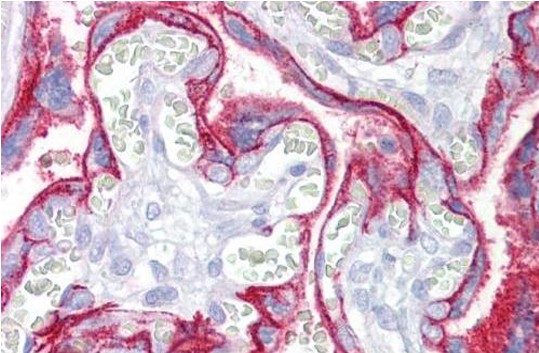Anti-CD46/Membrane Cofactor Protein [3F1]
Anti-CD46/Membrane Cofactor Protein [3F1]
Product No.: 90004
- -
- -
Clone 3F1 Target CD46/Membrane Cofactor Protein Formats AvailableView All Product Type Monoclonal Alternate Names TLX, Trophoblast leukocyte common antigen, CD antigen CD46 Isotype IgG1 Applications ELISA , IHC , WB |
Data
- -
- -
Antibody DetailsProduct DetailsReactivity Species Human Host Species Mouse Immunogen Recombinant human CD46. Formulation Lyophilized in PBS. State of Matter Lyophilized Product Preparation Purified by Protein A affinity chromatography Storage and Handling This product is stable for at least one (1) year at -20°C to -70°C. Reconstituted product should be stored in appropriate aliquots to avoid repeated freeze-thaw cycles. Country of Origin USA Shipping Next Day 2-8°C Applications and Recommended Usage? Quality Tested by Leinco Immunohistochemistry: use at 1- 10ug/ml. Immunoblotting: use at 0.5-1ug/ml. A band of ~44kDa is detected. Additional bands due to glycosylation of CD46 may be detected.ELISA: use at 0.1-1ug/ml with human CD46 on the solid phase. These are recommended concentrations. Enduser should determine optimal concentrations for their applications. Each investigator should determine their own optimal working dilution for specific applications. See directions on lot specific datasheets, as information may periodically change. DescriptionSpecificity Mouse Monoclonal Antibody specific to CD46/Membrane Cofactor Protein Background CD46 / Membrane Cofactor Protein is a type I membrane protein and is a regulatory part of the complement system; it has cofactor activity for inactivation of complement components C3b and C4b by serum factor I which protects the host cell from damage by complement. This protein also acts as a receptor for the Edmonston strain of measles virus, human Herpes virus-6 (HHV-6), and type IV pili of pathogenic Neisseria. Of interest is that medulloblastoma (a malignant brain tumor common in childhood) specimens express a high level of CD46. Antigen DetailsFunction Acts as a cofactor for complement factor I, a serine protease which protects autologous cells against complement-mediated injury by cleaving C3b and C4b deposited on host tissue. May be involved in the fusion of the spermatozoa with the oocyte during fertilization. Also acts as a costimulatory factor for T-cells which induces the differentiation of CD4+ into T-regulatory 1 cells. T-regulatory 1 cells suppress immune responses by secreting interleukin-10, and therefore are thought to prevent autoimmunity. {PubMed:10843656, PubMed:12540904}.; (Microbial infection) A number of viral and bacterial pathogens seem to bind MCP in order to exploit its immune regulation property and directly induce an immunosuppressive phenotype in T-cells.; (Microbial infection) Acts as a receptor for Adenovirus subgroup B2 and Ad3. {PubMed:12915534, PubMed:14566335, PubMed:15047806, PubMed:15078926, PubMed:15919905, PubMed:16254377}.; (Microbial infection) Acts as a receptor for cultured Measles virus. {PubMed:10972291}.; (Microbial infection) Acts as a receptor for Herpesvirus 6/HHV-6. {PubMed:12663806, PubMed:12724329}.; (Microbial infection) May act as a receptor for pathogenic bacteria Neisseria and Streptococcus pyogenes (PubMed:7708671, PubMed:9379894, PubMed:11260136, PubMed:11971006). NCBI Gene Bank ID UniProt.org Research Area Growth Factors, Cytokines, Receptors References & CitationsTechnical Protocols |
Formats Available
 Products are for research use only. Not for use in diagnostic or therapeutic procedures.
Products are for research use only. Not for use in diagnostic or therapeutic procedures.



